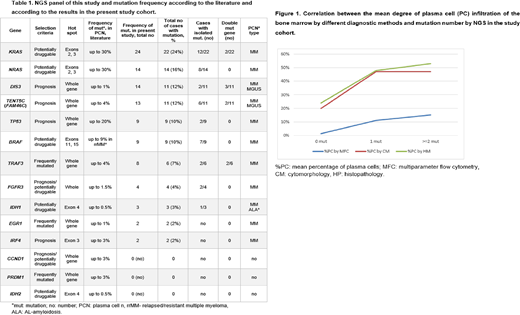Practical guidance on diagnostic and prognostic use of next generation sequencing (NGS) in multiple myeloma (MM) and other plasma cell neoplasms (PCN) has yet to be developed. To this end, we analyzed the correlation of NGS data with the degree of bone marrow (BM) plasma cell (PC) involvement obtained by cytomorphology (CM), histopathology (HP), and multiparameter flow cytometry (MFC) from patients with PCN/MM.
To perform this correlation, we analyzed 90 PCN cases, that included MM (n=77), MGUS (n=7), AL-amyloidosis (ALA) (n=4) and solitary plasmocytoma (SP) (n=2). The degree of BM infiltration (percent of PC) was defined by MFC as grade I <1%, grade II 1-3%, grade III >3%; by CM as grade I <10%; grade II, 10-30%; grade III >30% and by HP as grade I <10%, grade II 10-30%, grade III >30%. The newly designed NGS panel consisted of 15 genes including splice sites or hotspots: BRAF (exons 11, 15), CCND1, DIS3, EGR1, TENT5C (FAM46C), FGFR3, IDH1 (exon 4), IDH2 (exon 4), IRF4 (exon 3), KRAS (exons 2, 3), MYD88 (L265P), NRAS (exons 2, 3) PRDM1, TP53 and TRAF3. Genes and hotspots were chosen according to the frequency in the literature, prognostic impact, and possible function as therapeutic targets (Chapman et al., Nature 2011; Walker et al., JCO 2015). PC enrichment based on CD138+ magnetic cell sorting of marrow samples was successfully performed before the NGS procedure in all cases.
In total, 102 mutations were detected by NGS in 64/90 (71%) cases analysed, 26 cases (29%) showed no mutations. In 41 cases (45%) one mutation/sample was detected and in 23 (26%) two to five mutations/sample. The proportion of cases affected by mutations was 59/77 patients (77%) in MM, 2/7 (29%) in MGUS and 1/4 (25%) in ALA. The most frequent mutations across all PCNs types were KRAS 22/90 (24%) and NRAS 14/90 (16%), followed by DIS3 and TENT5C in 11/90 cases each or 12% (Table 1).
Mutational load correlated with degree of bone marrow infiltration: BM samples with no mutation had the lowest plasma cell infiltration: mean 1.6% by MFC (range, 0.003 - 11.7%), 20% by CM (1 - 90%), and 24% by HP (1 - 80%). Presence of at least one mutation/sample corresponded to a higher degree of BM involvement with a mean of 11% pathologic PC by MFC (range, 0.002 - 62%), and ~50% (3 - 100%) as defined by both CM and HP (Figure 1).
The majority of samples without mutation (26 cases, 29%) were obtained from patients with initial BM evaluation for PCN suspicion (19/26 cases or 73% of this subgroup), whereas BM samples with >1 mutation (23 cases, 26%) were mostly acquired from patients with relapsed/refractory disease (15/23 cases, or 65% of this subgroup). TP53 mutated cases had the highest percentage of PC infiltration by all methods and were mostly correlated to relapsed/refractory MM (rrMM).
In conclusion, the probability to detect a mutation by NGS in the BM was highest in samples with >10% clonal PC by flow cytometry, or >20% PC by CM/HP. We propose further evaluation of these thresholds as a practical cut-off for processing of samples by NGS at initial PCN/MM diagnosis, whereas disease progression is commonly associated to higher rates of mutations. TP53 mutation was detected in all but one samples from rrMM and was associated with the highest degree of BM involvement. Further large-scale studies are warranted.
No relevant conflicts of interest to declare.
Author notes
Asterisk with author names denotes non-ASH members.


This feature is available to Subscribers Only
Sign In or Create an Account Close Modal